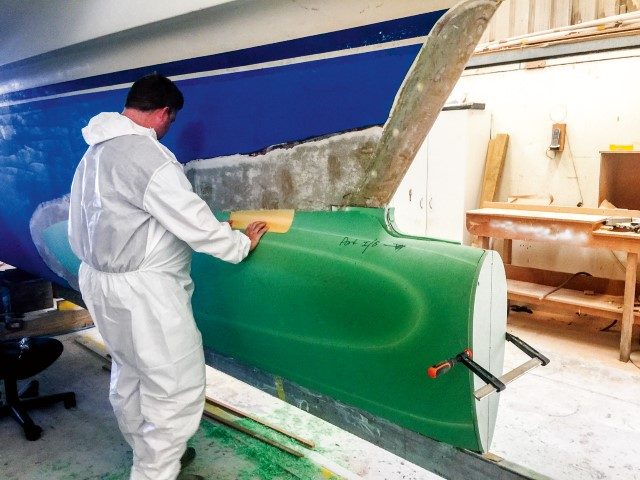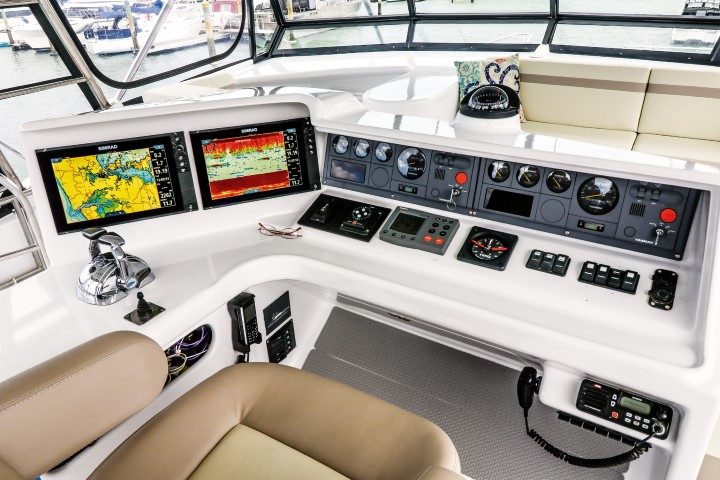

After a decade of operating a 17m ocean-going power cat, her owners knew her every quirk and foible, failure and frustration in annoying detail. Fixing them demanded a near-total rebuild, writes Peter Elliott. Photos by the writer and supplied.
The first thing that strikes me about November Rain as I stroll down to meet her and her owners at Pine Harbour is how tidy and pretty she looks on the water. Neat as a pin, gleaming with a new flybridge and tuna tower, she’s an airy pyramid of light and brightwork.
Designed by Malcolm Tennant and built by Dave Pachoud in 2002, the cat is wide and offers the extraordinary platform for fishing and liveability demanded by owners Garry and Lori Tanner. She’s their sea home for 180 days per year, and after the mammoth rebuild project, they concede they finally have their perfect boat.

She was lying in Hawaii when the couple bought her in 2007. It took three weeks to bring her back to New Zealand. She normally lives in Whangaroa, close to the big game fishing mecca of the far north, and it is what Lori and Garry live for these days.
They make a delightful team – funny, engaged, committed and serious about fishing and pursuing a life that most can only dream of. But getting there has taken hard work, dedication and sacrifice. Including that of the willing party of friends and crew who regularly join them for their tours throughout the Pacific. Australia, Vanuatu, Tonga are regular destinations for game-fishing, and they have had Norwegians, Brits, Scots, Australians, Kiwis and Swedish folk aboard helping them run the ship, and fishing for months at a time.
But to optimize these experiences, they needed to change the boat.
THE REFIT
A complete overview of the job would fill the entire magazine, and I’m hard-pressed to find anything that hasn’t been changed in some way. The original galley was ripped out and placed where the dining table was, the saloon has grown and offers more berths for friends on board.

A new bridge has been forged and the upper helm station moved back by 2.2m, creating seating areas with infill berths and improved visibility down to the new semi-circular transom deck, complete with game chair. In each rear corner of this deck a further extension has allowed for covered helm stations – and tagging capacity right at the stern.

With the new upper helm station, shade now covers the rear deck. It features another couple of berths, with roll-down screens for weather protection. A foldable table with rear seating configuration has a large freezer below.
Darkly dubbed ‘the coffin’ because it will fit a whole body lengthways, it offers clever use of space for the rare catch the couple keep. The rear deck areas have all been repainted with non-slip grip to match the cross-hatched hard surfaces of the fore and side decks.

Electrically, the boat has been totally transformed with new looms and wiring harnesses routed through conduit and removable inspection hatches, into the neatest of electrical switchboards – easily accessible and readable by all.
Six batteries and a discreet solar panel array keep the boat powered and operating for months at sea. A new spiral staircase has been configured, utilising the space created by the extended bridge above, allowing Lori and the crew the possibility of delivering drinks without hanging off the old ‘death ladder’ that went to the dumpster in the refit.
Beneath is a washing machine hidden behind lockers. This moves the laundry operation outside, but keeps it undercover. The head and shower facilities would grace a penthouse apartment. The new galley is also a work of craftsman’s perfectionism, with solid, gleaming wooden lockers, doors and drawers, all with soft-closing.

There is superb refrigeration and clever use of the sink and waste. Ovens and microwaves are firmly mounted, and by all accounts Lori is a legendarily superb baker, so I’m looking forward to my return visit.
Up forward the master’s stateroom and crew quarters for three have both been revamped with new hatches and windows, and modern decor.

In the super-comfortable saloon a 40-inch television swings down from above. Over 2000 movies and TV shows are available on the hard drive. The layout’s like a large, plush, private viewing room, and the dining table moves, slides and unfolds like some conjuring trick – to reveal a large dining and entertaining arena for colder weather.
This new-found space was created by removing the internal helm station (it was never used) and, as it took up much of the prime central internal position, removing it had the effect of doubling the living space.
It also exposed an internal bulkhead, above the galley and out of the way, where the top of the line ‘game gear’ can be stored; dry, clean and easy to hand at any time. Flooring, carpets, head-linings and window coverings have all been replaced and modernised, giving an ‘up-to-the-minute’ feeling. New windows have increased the views dramatically.

Engines too, have been replaced – an upgrade to a pair of new, six-cylinder 370hp Yanmar diesels. With 5,000 litres on board the cat has a cruising range in excess of 3,000 miles. It took a number of sea trials to find the correct propeller pitch/ size, but Garry now gets the same fuel economy with a faster cruising and top speed.
Time will tell if it creates the magic ‘note’ that draws the fish.
BULBS
But the most extraordinary change of all has been to the hulls. Garry wanted to change the ‘wet’ nature of the boat in a sea, and worked with designer Tony Sampson and naval architect Christian Stimson to deliver something quite radical – the addition of bulbous bows, slightly increasing waterline length and considerably improving handling.

These 3m bulbs use 80kg PVC foam with internal bulkheads, and the frontal lobes are made of 100kg PVC foam, and covered in three layers of glass. After more than 300 hours of exhaustive trials and testing, it was found that the boat porpoised a little, so some hull mods were crafted.
The additions included 100mm of beam, 5m of length and 700mm of draft. This delivered much-improved stability and a smoother ride – and what was once a wet boat is now very dry indeed.

Perhaps the proudest addition to this astonishing refit is the new tuna tower, which Garry found after it had been removed from another boat. With remarkable synchronicity it fitted November Rain perfectly, and only needed additional legs to reach forward to the foredecks.
Climbing out of the upper helm station in the starboard corner, requires something of a ‘feat of belief’ as one swings up and over the fly-bridge roof coaming and onto the ladder leading to the viewing platform and upper controls.
At around 7m high, the view from above is almost dizzying, but Garry says it will make his passages through atolls and reefs much easier and safer. I can see what he means, but it will take a strong stomach to handle the movement up there when it’s ‘game on’.

This newly-configured boat is obviously ready for action. The sheer quality of the build and the fittings is a testament to the enthusiasm Lori and Garry share for the sea, the boat, the lifestyle, the fishing and the crews and friends.
It’s now their dream home. It shows in the detail – every crafted and thought-out softened line; in the perfectly-placed handrail, the rounded corner, an ingeniously located storage locker, ovens and fridges – and storage. Massive storage. As Lori drily remarked, “when we go offshore we need a LOT of food.”
Jared Kirby, the new owner of Pine Harbour’s Harkin Boat Building, oversaw much of the revamp – and during the process took on the reins of the company itself. He’s rightly very proud of what’s been achieved, and the incredible effort needed to pull some 25 contractors together into one massive logistics puzzle. The thinking that went into revitalising this boat equates to thousands of hours; designers, architects, upholsterers, electricians, painters, carpenters, engineers, prop-swingers, and the plethora of tradespeople that came together to deliver a purpose-built passion for the owners.
DETAIL
In all of this change, one small detail comes to mind, and I think it’s typical of the intelligence buried in every pore of this cat. The new flybridge now extends 2.25m over the rear deck, providing shade in the tropics, extending the living area by at least 30 percent, and outside berths. Brilliant, but that’s not it.

It increases the upstairs area to a single, modular new helmstation with covered screens, and anchors the eponymously monogrammed and refurbished skipper’s chair. It offers viewing areas that weren’t there before, also doubles as a third dining area, and converts to yet another double berth.
But that’s not it either.
To support the increased weight of the new flybridge, two poles were added in each corner. Fashioned from carbon fibre, they are lighter and stronger than steel, so they won’t rust or crack or peel.
But – because they are hollow, they also take all the wet weather and saltwater spray from the upper decks and funnel the water down into a wastewater system that passes straight out through the hull. For me, that epitomises the sort of original thinking that went into this boat.
The result is a purpose-honed, powerful, economical, fishing platform with five-star live-aboard comfort and style, and five-star sea-worthiness. She’s a cracker.
Prior to starting the revamp, Lori said their “wish list was as long as Santa’s beard”.
Well, I think Santa delivered. November Rain got an April Christmas.




